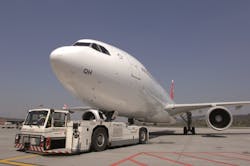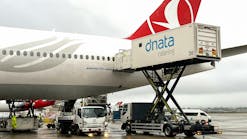Mexico's Ground Handlers Plan for Expansion
Like the rest of the aviation industry, aircraft ground handling in Mexico is experiencing significant growth. This is posing a challenge to the industry in terms of handling infrastructure saturation.
In order to respond to this growth challenge, ground service providers (GSPs) are responding by investing in equipment and upgrading fleets to keep up with the expansion pattern.
Expanding Industry
Mexico City International Airport (MMMX) is the most representative airport in terms of traffic, growth and development. MMMX in 1980 had 51 registered vehicles for ground services, whereas in 2016 it had 1,687 vehicles (including authority vehicles).
Moreover, since 2006, new low cost airlines have been offering services, and the result has been an increase in passenger throughput requiring new ground services providers. While in 2003, there were approximately 12 ground services providers, over the years new companies have been created and some have specialized in different services – such as security, catering, cargo, ground handling, passenger services, etc. – and now MMMX has 82 registered companies operating at the airport.
“There is now a big concern by the airport authorities regarding the quality of delivered services. There are more options for the airlines, which are now joining forces to demand quality assurance programs like ISAGO (IATA Safety Audit for Ground Operations) and SMS (Safety Management System) implementation. This is also supported by Mexican CAA regulations. Many companies are also working with best practices published by IATA, ICAO, ACI, etc., as well as sharing incident information and lessons learned,” says Jorge Alva, Regional Director, Latin America and Caribbean at Universal Aviation.
“Low cost airlines are increasingly expecting faster turnaround times and lower costs. This requires better staff and equipment planning,” he adds. “Airports now have more strict requirements in terms of training, maintenance programs, audits and supervision during operations as well as applying fines as necessary when in violation. Staff rewarding and recognition programs are also important to maintain team safety commitment and morale.”
Constrained Infrastructure
Mexican airline Interjet has been coping with the growth of the airline business in Mexico by establishing operational procedures that comply with international standards such as using the IATA Ground Operations Manual (IGOM) as a baseline in all procedures.
“The implementation of new technologies during the accomplishment of ground operations represents today a great window of opportunity for our airline, as it can make operations more efficient and accurate. However, the saturation of the airport infrastructure represents the biggest challenge to our operations,” say officials at Interjet.
“Certainly, the aviation industry in Mexico shows growth due to the new low cost or semi-low cost carriers which bring the opportunity to the Mexican people to have access to air transportation. Moreover, new carriers entered in the last years and some others are looking into the option to increasing their activity and fleet. From our perspective, besides business opportunities, this progress also generates huge challenges in Mexico, since there are only a couple of companies with the structure and capabilities to grow at the same proportion that is required to match the increase in traffic and comply with the industry requirements,” says Diego Ramirez, Head of Mexico and Central America Cluster at Swissport.
“Therefore, we have to be very attentive when it comes to organizational structure, infrastructure, investment strategies, etc. All this should be oriented in strict harmony with the carriers, governmental bodies and other third parties. In this way, we can ensure high quality levels and be an integral part of the industry developments, based on a very strong and sustainable model.”
Ramirez notes that the most obvious example of infrastructure saturation is MMMX.
“This is quite a complex airport from an operational and infrastructure point of view. In order to counteract these challenging external factors, we have equipped ourselves with more than 60 percent new GSE and aligned the strategy to a systematic renewal of our fleet within the next two years,” he says. “This way, we can deliver high quality services and approved operational safety standards (Swissport Formula) to our customers and the airport. For 2018, we are directing our efforts towards our new growth plan, including several investments in our human capital and infrastructure. All these improvements will help us to be an active part of the current growth in Mexico.”
Technological Upgrades
Ground support equipment (GSE) fleet upgrades are indeed key to ensure that the industry best handles the challenges related to growth.
“Big and well established companies are investing in new technology, especially for towing,” says Universal Aviation’s Alva.
“New GSE plays a relevant role in aviation on-time performance and in passenger experience and airlines costs. Aeromexico Servicios, the largest GSP in Mexico, has invested $15.5 million (USD) in the last four years to renew GSE equipment. The ground handling industry has focussed on new GSE technologies, especially on the development of electric vehicles. However, because of infrastructure constraints at Mexican airports – such as the lack of areas for charging electric GSE, not many companies have invested in this kind of technology,” say officials at Aeromexico Servicios, the airline’s ground handling subsidiary.
In order to operate in an environmentally friendly manner Interjet also opted for electric vehicles.
“This type of vehicle has several design improvements to increase reliability and performance, and it is designed for towing baggage, freight mail, carts/cargo dollies and pallet dollies. The unit features a proven design, rugged front and rear axles, and the latest in AC controller technology. The standard unit used by Interjet is capable of a top running speed of 18 mph (29 Km/h) when empty, and has a drawbar pull of 4,000 lbs. (1814 Kg),” say Interjet officials. “Power for the main drive is supplied by a high-efficiency low maintenance AC motor that is directly coupled to the rear axle. Power steering is provided with a hydraulic accumulator, which provides quieter and smoother operation.”
“The new equipment accomplishes basically the same thing as older equipment, but the new technologies makes aviation a better and safer place to work. This is, of course, a direct benefit to the employees who keep the business running every day. And, of course, also to our airline customers,” Swissport’s Ramirez agrees. “We can now increasingly see offloading conveyor belts, which go into the compartment, making the offloading process easier to the employees and saving precious time. There is equipment with proximity sensors which avoid damages to the airplanes. There are new pushback tractors, which allow us to speed up the towing process. We now have access to ground power units with a combination of air conditioning units, which save fuel and are less harmful to the environment. In the past, we needed two separate units.”
Hot Temperatures
While there are normally nice weather conditions in most parts of the country, the stations in the north of Mexico suffer occasionally from extreme weather conditions.
“For those cases, we are well prepared. Next to approved operational procedures, we also have all the necessary safety measures in place to protect our valued employees – such as specific personal protective equipment (PPE), the GSE and the infrastructure,” says Swissport’s Ramirez. “Furthermore, we have to deal with high temperatures in some areas or very salty environments as a result of the closeness to the sea. In those cases, the key is to have solid preventive maintenance to all our GSE and provide our staff with adequate uniforms in order to make their lives easier as much as possible. Also, at these locations, the hurricane season is always a threat, so different emergency plans are previously prepared and tested.”
A Positive Outlook
The outlook of the aircraft ground handling industry in Mexico remains one of positive growth.
“The International Monetary Fund (IMF) forecasts that the growth of the Mexican economy from 2018 to 2020 will be higher than 3 percent a year. This, of course, means good news for the aerospace industry as a whole, and therefore also for the ground handling industry. According to the Treasure and Economy Ministry, from a short and medium term perspective, it can be said that the aerospace industry has an immense opportunity to consolidate as a strategic sector with great potential to have pull effects on other sectors and the economy itself,” says Ramirez of Swissport. “According to short-term forecasts, the aerospace industry will grow much faster than the national economy.”
It is noteworthy that the new international airport for Mexico City will open in 2020 and replace MMMX.
“With the implementation of the new airport, expectations for 2020 are high because of the growth opportunities that airlines will have and the potential for implementing new technologies,” say Aeromexico Servicios officials.
“There are big opportunities for growth in both passengers and cargo, especially with the new Mexico City airport under construction,” adds Universal Aviation’s Alva. “There is also important growth in regional traffic demanding new service providers. The challenge is to get good quality and pricing at regional airports where the traffic is not so intense.”





